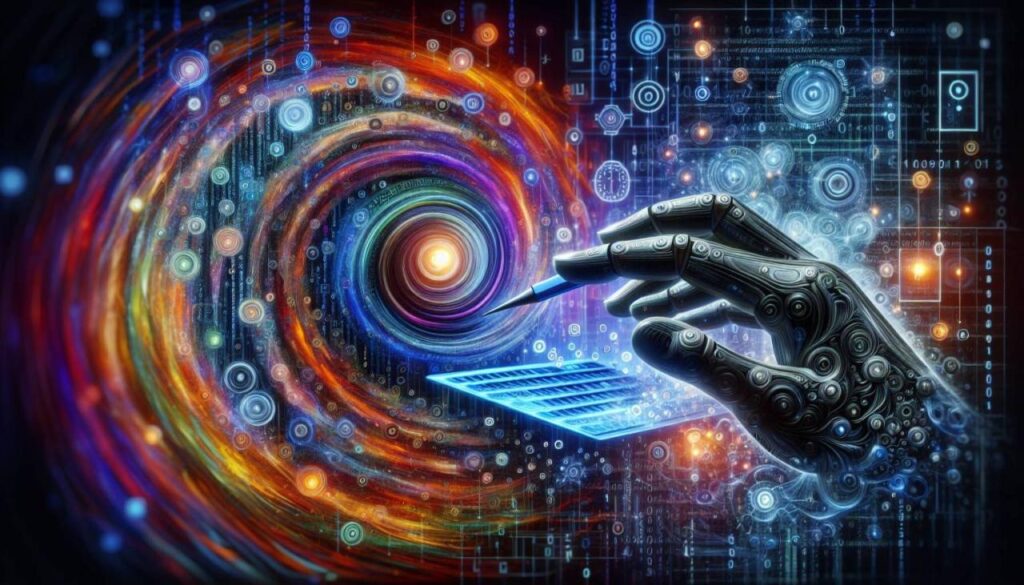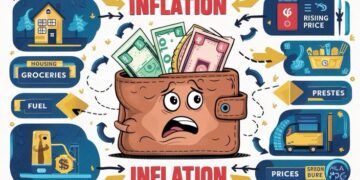The advent of Artificial Intelligence (AI) isn’t just a technological advancement; it’s a fundamental economic earthquake, reshaping the very foundations of global markets. From Wall Street to Jakarta, industries are grappling with AI’s unprecedented capacity to automate, optimize, and innovate, creating both immense opportunities and significant disruptions. For businesses, investors, and policymakers, understanding AI’s pervasive influence is no longer optional. Its impact is a critical trending topic, vital for securing high Google AdSense revenue through insightful, comprehensive content that addresses this transformative shift. This in-depth article will explore the multifaceted ways AI is impacting global markets, examining its revolutionary applications, the economic shifts it engenders, the challenges it presents, and the strategic imperatives for navigating this new technological frontier.
The AI Revolution: More Than Automation
At its core, AI refers to the simulation of human intelligence processes by machines, especially computer systems. These processes include learning, reasoning, problem-solving, perception, and even language understanding. While automation is a significant part of AI’s appeal, its true revolutionary power lies in its ability to analyze colossal datasets, identify intricate patterns, make predictions with remarkable accuracy, and even generate creative solutions, all at speeds and scales impossible for humans. This capability is fundamentally altering how industries operate, how decisions are made, and how value is created and distributed in the global economy.
Key facets of the AI revolution include:
- Machine Learning (ML): A subset of AI that enables systems to learn from data without explicit programming. This includes supervised, unsupervised, and reinforcement learning, allowing AI to improve performance over time.
- Deep Learning (DL): A subfield of ML using neural networks with multiple layers to learn complex patterns from large amounts of data, particularly effective in areas like image and speech recognition.
- Natural Language Processing (NLP): Empowers AI systems to understand, interpret, and generate human language, revolutionizing customer service, content creation, and data analysis.
- Computer Vision: Enables machines to “see” and interpret visual information, crucial for autonomous vehicles, robotics, and quality control in manufacturing.
- Generative AI: AI models capable of generating new content, such as text, images, audio, and even code, with profound implications for creative industries and R&D.
These technologies aren’t merely improving existing processes; they are enabling entirely new business models, product offerings, and market dynamics that were previously unimaginable.
AI’s Transformative Impact Across Key Global Sectors
AI is not a niche technology; its applications are incredibly diverse, permeating nearly every sector of the global economy and fundamentally redefining competitive landscapes.
A. Finance and Banking: Precision and Risk Management
The financial sector is arguably one of the earliest and most profound beneficiaries of AI, using it to enhance efficiency, reduce risk, and create new investment strategies.
- Algorithmic Trading: AI-powered algorithms analyze market data at lightning speed, executing trades in milliseconds, often outperforming human traders. This includes high-frequency trading and sophisticated quantitative strategies.
- Fraud Detection: AI systems are highly effective at identifying anomalous transaction patterns that indicate fraudulent activity, significantly reducing financial losses for banks and consumers. Machine learning models continuously learn from new fraud cases, adapting their detection capabilities.
- Credit Scoring and Loan Underwriting: AI processes vast amounts of alternative data (beyond traditional credit history) to assess creditworthiness more accurately, potentially extending credit access to underserved populations while minimizing lender risk.
- Personalized Financial Advice (Robo-Advisors): AI-powered platforms offer automated, data-driven investment advice and portfolio management, making financial planning more accessible and affordable.
- Risk Management: AI models predict market volatility, credit defaults, and operational risks with greater precision, allowing institutions to proactively manage exposures and comply with complex regulations. This includes stress testing and scenario analysis.
- Customer Service: AI-powered chatbots and virtual assistants handle routine customer inquiries, improving response times and freeing human agents for complex issues.
B. Healthcare and Life Sciences: Diagnostics to Drug Discovery
AI is revolutionizing healthcare, promising more precise diagnoses, personalized treatments, and accelerated drug development.
- Diagnostic Assistance: AI algorithms can analyze medical images (X-rays, MRIs, CT scans) with high accuracy, assisting radiologists in detecting diseases like cancer earlier and more reliably than human eyes alone.
- Drug Discovery and Development: AI accelerates the identification of potential drug candidates, predicts molecular interactions, and optimizes clinical trial designs, drastically reducing the time and cost associated with bringing new medicines to market.
- Personalized Medicine: AI analyzes a patient’s genetic data, medical history, and lifestyle to predict disease risk and recommend highly individualized treatment plans, moving towards precision healthcare.
- Predictive Analytics for Outbreaks: AI models can analyze public health data to predict disease outbreaks and pandemics, enabling proactive public health interventions.
- Robot-Assisted Surgery: AI-powered robotics enhance surgical precision, minimize invasiveness, and improve patient outcomes.
- Virtual Health Assistants: AI chatbots provide immediate medical information, symptom checking, and appointment scheduling, improving access to basic healthcare guidance.
C. Manufacturing and Supply Chain: Efficiency and Resilience
AI is transforming manufacturing from rigid production lines to agile, intelligent factories, while making supply chains more robust.
- Predictive Maintenance: AI monitors equipment performance in real-time, predicting potential failures before they occur, reducing downtime and maintenance costs.
- Quality Control: Computer vision systems powered by AI can inspect products on assembly lines with unparalleled speed and accuracy, identifying defects that human eyes might miss.
- Optimized Production Planning: AI algorithms can analyze demand forecasts, material availability, and production capacity to create highly efficient schedules, minimizing waste and maximizing output.
- Robotics and Automation: AI enables robots to perform more complex and adaptive tasks in manufacturing environments, from assembly to intricate material handling.
- Supply Chain Optimization: AI predicts demand fluctuations, optimizes logistics routes, manages inventory levels, and identifies potential disruptions (e.g., weather events, geopolitical issues), creating more resilient and efficient supply chains.
- Digital Twins: AI-powered virtual replicas of physical assets (factories, machines) allow for simulation and optimization of processes in a virtual environment before real-world implementation.
D. Retail and E-commerce: Personalized Experiences
AI is reshaping how consumers shop and how retailers operate, driving personalization and operational efficiency.
- Personalized Recommendations: AI algorithms analyze Browse history, purchase patterns, and demographics to offer highly relevant product recommendations, significantly boosting sales.
- Dynamic Pricing: AI continuously adjusts product prices based on real-time demand, competitor pricing, inventory levels, and other market factors to maximize revenue.
- Inventory Management: AI predicts demand with greater accuracy, optimizing stock levels, reducing waste from overstocking, and preventing lost sales due to stockouts.
- Customer Service Chatbots: AI-powered chatbots handle customer inquiries, order tracking, and returns, providing instant support 24/7.
- Visual Search and AI-Powered Fitting Rooms: AI enables customers to find products using images and even virtually “try on” clothes, enhancing the shopping experience.
- Store Layout Optimization: AI analyzes foot traffic patterns and sales data in physical stores to suggest optimal product placement and store layouts.
E. Transportation and Logistics: Autonomy and Efficiency
AI is a cornerstone of the next generation of transportation, from self-driving cars to optimized shipping routes.
- Autonomous Vehicles: AI is the brain behind self-driving cars, trucks, drones, and even ships, promising safer, more efficient, and eventually, more affordable transportation.
- Route Optimization: AI algorithms analyze real-time traffic, weather, and delivery schedules to optimize routes for efficiency, reducing fuel consumption and delivery times.
- Fleet Management: AI monitors vehicle health, predicts maintenance needs, and optimizes deployment, ensuring fleets operate at peak efficiency.
- Traffic Management: AI systems analyze traffic flow patterns to dynamically adjust traffic lights and manage congestion in smart cities.
- Warehouse Automation: AI-powered robots and automated systems handle sorting, picking, and packing in warehouses, significantly increasing throughput.
Economic Shifts Driven by AI: Opportunities and Challenges
The widespread adoption of AI is not merely improving existing processes; it’s triggering fundamental economic shifts, creating both unprecedented opportunities for growth and significant challenges for labor markets and societal structures.
A. Productivity Growth and Economic Expansion
AI’s ability to automate routine tasks, optimize complex processes, and generate insights from vast datasets is leading to significant productivity gains across industries. This enhanced productivity is a key driver of economic growth, potentially leading to:
- Lower Production Costs: Automation and optimization reduce labor and operational expenses.
- Increased Output: Companies can produce more goods and services with the same or fewer inputs.
- New Products and Services: AI enables the creation of entirely new categories of products and services (e.g., personalized medicine, advanced robotics, generative content platforms).
- Enhanced Innovation: AI accelerates research and development, allowing for faster breakthroughs in science and technology.
B. Labor Market Transformation
Perhaps the most discussed and debated impact of AI is its effect on the job market. This isn’t just about job losses; it’s about a fundamental reshaping of skills and roles.
- Automation of Routine Tasks: AI is highly capable of performing repetitive, predictable tasks, leading to job displacement in sectors like manufacturing, customer service, and administrative support.
- Augmentation of Human Capabilities: AI often acts as a co-pilot, enhancing human decision-making and productivity rather than replacing jobs entirely. Designers use generative AI, doctors use AI for diagnostics, and lawyers use AI for legal research.
- Creation of New Jobs: AI’s development and deployment create demand for new roles such as AI engineers, data scientists, prompt engineers, AI ethicists, and robot maintenance technicians.
- Skill Gap and Reskilling Imperative: The rapid pace of AI adoption creates a significant skill gap. There’s an urgent need for massive reskilling and upskilling initiatives to prepare the workforce for AI-augmented roles and entirely new jobs. Education systems must adapt to foster AI literacy and critical thinking.
- Gig Economy and Freelancing: AI tools can empower individual freelancers to compete with larger organizations, potentially expanding the gig economy.
C. Wealth Concentration and Income Inequality
There are concerns that AI could exacerbate wealth inequality if the benefits disproportionately accrue to a small number of AI developers, large technology companies, and highly skilled workers, leaving behind those whose jobs are automated.
- Winner-Take-All Markets: AI-driven network effects and economies of scale could lead to a few dominant firms monopolizing markets.
- Capital vs. Labor: AI shifts the balance towards capital (technology investment) over labor, potentially reducing labor’s share of income.
- Policy Interventions: Governments may need to explore policies like universal basic income (UBI), progressive taxation, or investment in public education and retraining programs to mitigate negative impacts.
D. Geopolitical and Competitive Landscape Shifts
AI is becoming a critical component of national power and global competitiveness.
- AI Arms Race: Nations are investing heavily in AI research and development for economic, military, and technological dominance.
- Data as a Strategic Asset: The “new oil” is data, and countries with vast, accessible datasets have a significant advantage in AI development.
- Ethical and Regulatory Challenges: Divergent approaches to AI regulation across countries could create trade barriers or competitive imbalances.
- Emerging Market Opportunities: AI can allow developing economies to leapfrog traditional development stages, but requires significant investment in infrastructure and education.
Challenges and Ethical Considerations in AI’s Global Impact
Despite its immense potential, AI also presents significant challenges and raises profound ethical questions that global markets must address.
A. Data Privacy and Security
AI systems are data-hungry. The collection, storage, and processing of vast amounts of personal and sensitive data raise concerns about privacy, surveillance, and the potential for data breaches.
- Consumer Trust: Misuse of data or privacy violations can erode public trust in AI technologies.
- Regulatory Frameworks: Development of robust data privacy regulations (like GDPR) is crucial, but global consistency is a challenge.
B. Algorithmic Bias and Fairness
AI models learn from the data they are trained on. If this data contains historical biases (e.g., racial, gender, socioeconomic), the AI can perpetuate and even amplify these biases, leading to unfair or discriminatory outcomes in areas like hiring, loan approvals, or criminal justice.
- Data Diversity: Ensuring training datasets are representative and diverse is critical.
- Bias Detection Tools: Developing tools to identify and mitigate bias in algorithms.
- Ethical AI Development: Prioritizing fairness, transparency, and accountability in AI design.
C. Explainability and Transparency (The “Black Box” Problem)
Many advanced AI models, particularly deep learning networks, are often “black boxes” – it’s difficult for humans to understand precisely how they arrive at their decisions. This lack of transparency poses challenges in regulated industries (e.g., finance, healthcare) where explainability is crucial for auditability, liability, and trust.
- Explainable AI (XAI): Research into methods for making AI decisions more understandable to humans.
- Regulatory Demands: Increasing calls for regulations that mandate AI explainability in critical applications.
D. Job Displacement and Social Inequality
As discussed, AI will displace jobs. Managing this transition requires proactive strategies to ensure a just transition for displaced workers and to prevent widening social inequality.
- Retraining and Education: Government and industry collaboration on large-scale retraining programs.
- Social Safety Nets: Re-evaluating existing social welfare systems to support those impacted by automation.
- Ethical Deployment: Companies prioritizing responsible AI adoption and considering societal impacts.
E. Cybersecurity Risks
AI can be used for both defense and offense in cybersecurity. While AI can enhance threat detection, it can also be leveraged by malicious actors to create more sophisticated cyberattacks (e.g., AI-generated phishing emails, autonomous malware).
- AI for Cybersecurity: Using AI to analyze threats, detect anomalies, and respond to attacks.
- Cybersecurity for AI: Protecting AI systems themselves from adversarial attacks (e.g., data poisoning, model evasion).
F. Global Governance and Regulation
The borderless nature of AI technologies makes global governance a complex challenge. Different countries have varying legal, ethical, and societal norms, making international consensus on AI regulation difficult.
- International Cooperation: Need for global dialogues and frameworks to address AI’s cross-border impacts.
- Ethical Guidelines: Developing universal ethical principles for AI development and deployment.
Navigating the AI Era: Strategic Imperatives for Global Markets
For nations, businesses, and individuals, effectively navigating the AI era requires foresight, adaptability, and strategic investment.
A. For Businesses: Adapt or Be Left Behind
Businesses must integrate AI into their core strategies, not just as an add-on.
- AI-First Mindset: Embrace AI as a strategic differentiator and enabler of new business models.
- Data Strategy: Invest in robust data infrastructure, collection, and governance, recognizing data as a critical asset.
- Upskilling and Reskilling Workforce: Proactively train employees for AI-augmented roles and future-proof skills.
- Ethical AI Frameworks: Develop internal guidelines and processes for responsible and ethical AI deployment.
- Strategic Partnerships: Collaborate with AI startups, research institutions, and technology providers.
- Experimentation and Iteration: Start small, experiment with AI solutions, and iterate based on results.
B. For Governments: Foster Innovation and Ensure Equitable Transition
Governments play a crucial role in creating an environment that fosters AI innovation while mitigating its risks and ensuring societal benefits.
- Investment in R&D: Fund basic and applied AI research to maintain technological leadership.
- Education and Workforce Development: Overhaul education systems to prepare citizens for the AI economy, emphasizing STEM, critical thinking, and AI literacy.
- Regulatory Frameworks: Develop balanced regulations that protect privacy, ensure fairness, and address liability without stifling innovation. This includes AI safety standards.
- Infrastructure Development: Invest in digital infrastructure (e.g., 5G, fiber optics, computing power) to support AI deployment.
- International Collaboration: Engage in global dialogues to shape AI governance and standards.
- Social Safety Nets: Explore policies to support displaced workers and address potential increases in inequality.
C. For Individuals: Embrace Lifelong Learning
Individuals must adopt a mindset of continuous learning and adaptability to thrive in the AI-transformed job market.
- Develop AI Literacy: Understand the basics of how AI works, its capabilities, and its limitations.
- Focus on “Human” Skills: Cultivate skills that AI currently struggles with: creativity, critical thinking, emotional intelligence, complex problem-solving, collaboration, and ethical reasoning.
- Embrace Lifelong Learning: Continuously acquire new skills through online courses, certifications, and vocational training.
- Network and Collaborate: Build professional networks and learn from peers who are adapting to AI.
A Future Forged by Intelligent Machines
The impact of AI on global markets is profound, pervasive, and accelerating. It is fundamentally reshaping industries, creating unprecedented opportunities for efficiency, innovation, and economic growth, while simultaneously presenting complex challenges related to labor displacement, ethical considerations, and global governance. The era of intelligent machines is not a distant possibility but a present reality, necessitating a proactive and adaptive response from all stakeholders. Nations that strategically invest in AI research, foster an innovative ecosystem, and implement equitable policies will likely emerge as leaders in this new economic order. Businesses that integrate AI into their core strategy, prioritize ethical deployment, and continuously upskill their workforce will thrive. And individuals who embrace lifelong learning and cultivate uniquely human skills will find themselves well-positioned to flourish alongside intelligent machines. The future of global markets will undoubtedly be forged by AI, and our collective ability to harness its power responsibly will determine the trajectory of prosperity and equity for generations to come.









